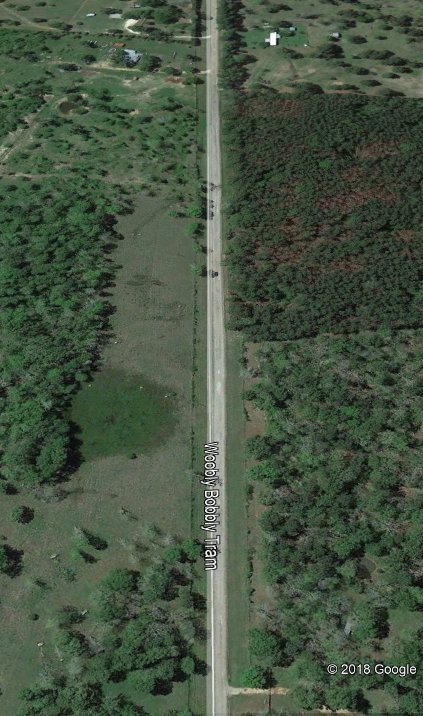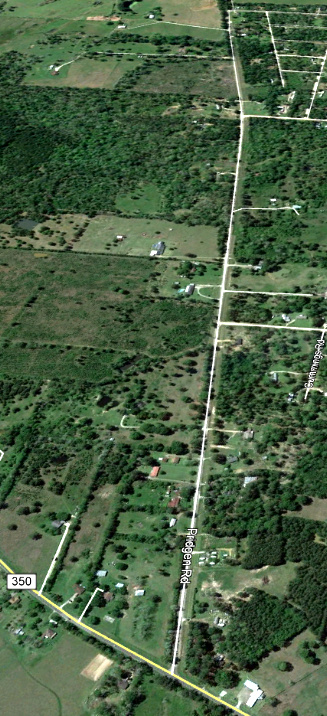Texas Railroad History - Tower 168 - West Livingston
A Crossing of the Houston East & West Texas
(HE&WT) Railway
and the Waco, Beaumont, Trinity & Sabine (WBT&S) Railroad

Above: In 1946, Robert W.
Richardson, founder of the Colorado Railroad Museum (CRM), was able to take a ride on
the WBT&S from Trinity to Livingston in a Model A Ford ("WBT&S #1") modified to
run on rails. Richardson took an 8-mm. film of his day on the WBT&S and
later edited his
footage into a short film. His film has been
converted to video and was made available by CRM to Jason Rose, webmaster for
the website wbtsrailway.net.
This image capture is taken from the video and is facing generally west-southwest down the WBT&S
from the
Tower 168 diamond. The passengers are walking toward the T&NO tracks having
disembarked from a trailer pulled behind the Model A visible in the distance.
It is not known whether the passengers were
planning to be picked up by the next T&NO train or merely walking into
Livingston. Note that the WBT&S south rail at the diamond has been cut on both
sides of the T&NO west rail, i.e. the WBT&S was no longer capable of crossing
the T&NO even though the interlocking plant had
not been officially removed at the time of Richardson's 1946 visit. The apparatus at the right edge of this image might be
associated with the "ground lever" control used by the Tower 168
interlocker (although at the time the
WBT&S rail was cut, surely the interlocker control was disabled, even if it wasn't
officially removed.) The video shows the Model A being turned 180 degrees for the return trip
to Trinity using a car
jack and a lot of manpower. Meanwhile, the trailer was manually pushed onto a
nearby siding and recoupled to the Model A after it passed on the return trip.
In 1877, the Houston East & West Texas (HE&WT) Railway began
construction of a
narrow gauge railroad north out of Houston, passing through the town of
Livingston in 1880. By then, Livingston had been settled more than 30 years,
having obtained postal service in 1847. Despite being the county seat,
Livingston had grown slowly, but that changed quickly with the arrival of the
railroad. In 1894, the HE&WT was converted to standard gauge and five years
later,
Southern Pacific (SP) bought the HE&WT but continued to operate it under that
name. In 1927, the HE&WT was leased to the Texas & New Orleans (T&NO) Railroad,
SP's principal operating subsidiary in Texas and Louisiana. In 1934, the
HE&WT was fully merged into the T&NO and ceased to exist as a separate
entity.
The huge growth in commercial timber that occurred in east Texas
in the 1890s also motivated the construction of short-line railroads to bring wood
products from mills to the main line railroads. One of these was the Livingston
& Southeastern Railway built in 1905 to connect the Knox Lumber Co. mill
east of Livingston with the HE&WT. Within eight years, the Knox lumber mill was
closed and the rail line abandoned. The next rail line into Livingston was the
newly chartered Beaumont & Great Northern (B&GN) which built a line to
Livingston from an International & Great Northern connection in the town of
Trinity during 1907-08. A few years later, the B&GN
was sold in several successive transactions and ultimately became owned by the
Missouri-Kansas-Texas (MKT, "Katy") Railroad. The sale to the Katy was fought in
court by the State of Texas and eventually annulled in a 1914 settlement wherein the Katy
then leased the B&GN for 99 years. But Katy's lease did not last long; the
Katy went
into receivership and the B&GN reverted to its owners as part of Katy's
emergence from bankruptcy in 1923. The B&GN's owners then changed the name to
the Waco, Beaumont, Trinity & Sabine (WBT&S) Railroad (and of the four
locations in the name, the railroad only went to Trinity.)
The B&GN most likely crossed the HE&WT in Livingston during its initial 1908
construction. The HE&WT had built north/south mostly along the west side of
Livingston, so reaching the main population of Livingston from the west
would require the B&GN to cross the HE&WT. In the last interlocker list published by the Railroad
Commission of Texas (RCT) dated 31 December 1930, Tower 168 is listed as "Under
Construction" at "West Livingston" to serve the HE&WT / WBT&S crossing.
The reason for the "sudden" need for the Tower 168 interlocker (the crossing had
existed for nearly 25 years) is unknown. However, a large number of unrelated
"minor" crossings were interlocked in 1930 and 1931 (potentially as many as 17
interlockers, but precise dates for some of the interlockers believed to be in
this timeframe are unknown.) Perhaps guidance was issued by RCT that motivated
this activity.
A
drawing obtained from SP's Houston office by Carl Codney states that Tower 168 was a
"ground lever plant" interlocker placed in service on 15 October 1931. The lever controlled two home signals for the
HE&WT, one in each direction, and two derails on the WBT&S, one in each
direction. Approaching WBT&S trains were required to stop before they reached
the derail near the crossing. A WBT&S crew member would exit the train and throw
the ground lever. This would signal a stop condition on the HE&WT and clear the
derails on the WBT&S. Once the WBT&S train had crossed the diamond and cleared
the derail, the crew member would return the lever to its normal position. This
signaled HE&WT traffic to proceed through the crossing without delay. At all
other times, the signals were lined to permit continuous operation on the HE&WT.
Ironically, the Tower 168 interlocker was installed
after the WBT&S had gone into receivership in February, 1930. During
three decades of receivership, parts of the railroad were gradually abandoned
until there was literally nothing left, in 1961, when it ceased to exist. The SP
drawing states that Tower 168 was taken out of service on 22 March 1947.
Presumably the crossing was removed at that time, but RCT records show that the
WBT&S tracks into Livingston weren't formally abandoned until 1949. The former
HE&WT line remains in service as a major route for Union Pacific (UP).
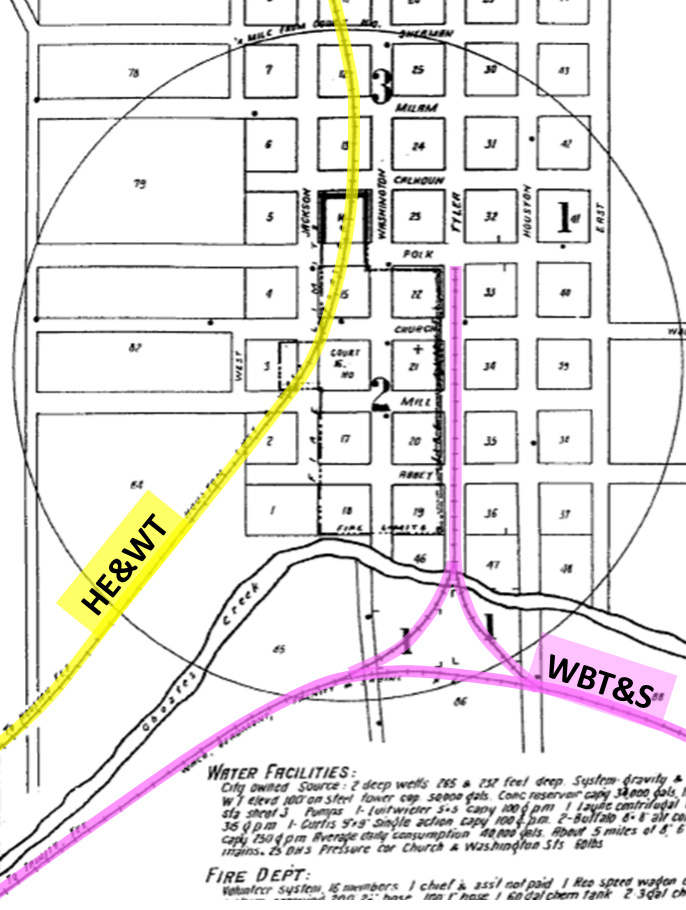
 Above Left: The HE&WT
and WBT&S crossed southwest of Livingston, a location off the lower left
corner of this
Sanborn Fire Insurance index map of Livingston from 1927. Above Right: This
SP drawing shows the functions controlled by the interlocker. Both railroads had a
total of 2 units, so the expenses were split 50/50. (Carl Codney collection)
Above Left: The HE&WT
and WBT&S crossed southwest of Livingston, a location off the lower left
corner of this
Sanborn Fire Insurance index map of Livingston from 1927. Above Right: This
SP drawing shows the functions controlled by the interlocker. Both railroads had a
total of 2 units, so the expenses were split 50/50. (Carl Codney collection)
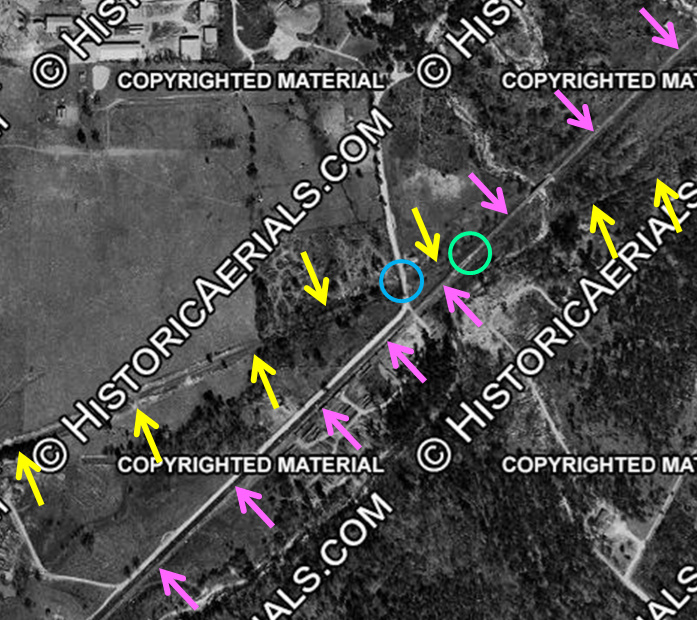
Above: This aerial image ((c)historicaerials.com) from 1952 has been
annotated to identify the Tower 168 crossing (green circle). Yellow arrows mark the
WBT&S right-of-way (ROW); with the WBT&S officially abandoned in 1949, the
WBT&S tracks may already have been removed by 1952. Pink arrows delineate the SP tracks. The blue circle marks a grade crossing where the WBT&S crossed S. Marsh, a
dirt road.
Below:
Although S. Marsh is a dirt road, it was captured by Google Street View in 2008.
This view is to the northeast and the camera is on S. Marsh where it makes a left turn due north. The UP main line is
parallel to S. Marsh and the visible grade crossing is an entrance for some kind
of construction activity unrelated to the railroad.
The WBT&S grade crossing of S. Marsh (blue circle above) is to the left
around the curve, but Google Street View at that location shows no telltale
signs that the WBT&S ever crossed there.
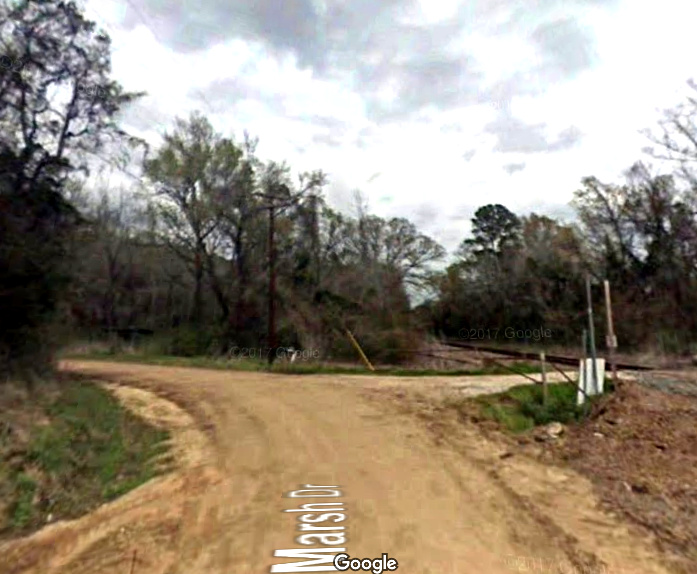
Below: Sanborn maps show the
WBT&S running parallel to and south of Ogletree (upper right corner). The
Ogletree Lumber Co. sawmill was served by the WBT&S about where W. Matthews and
Ogletree intersected. That intersection no longer exists; the sawmill is long
gone, replaced by a city park.
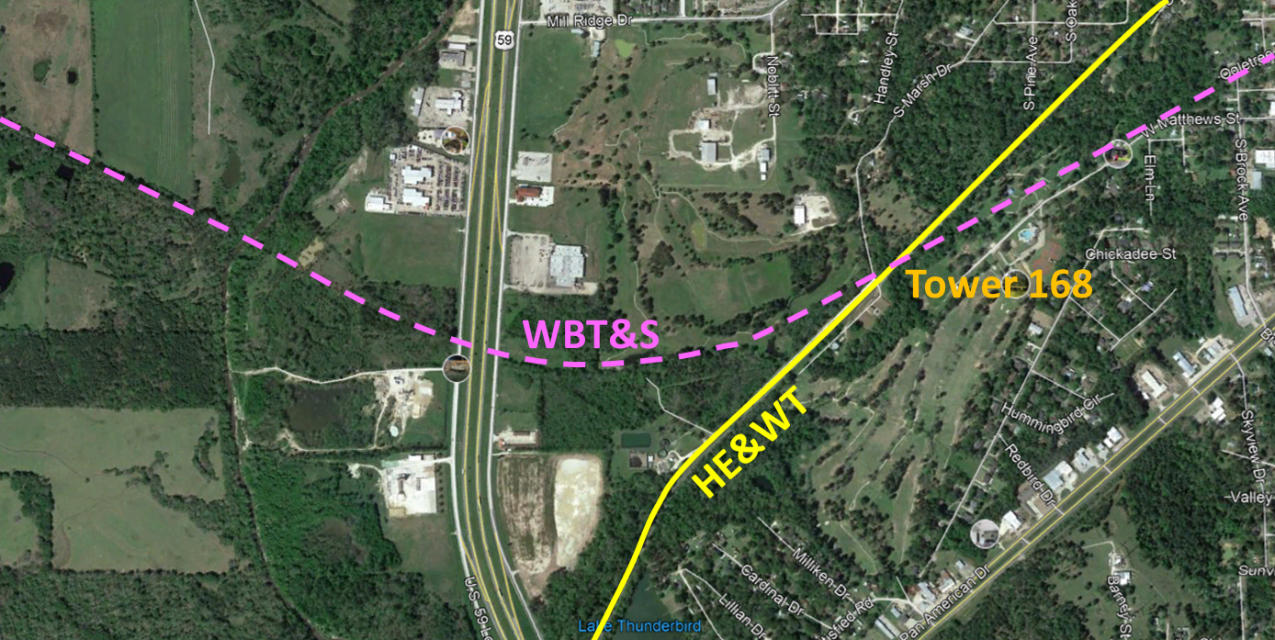
Below: West of Livingston, 1.25 miles of the
WBT&S grade is preserved as a rural road called Wobbly Bobbly Tram Road. This is
a reference to the local nickname for the WBT&S, "Wobbly Bobbly Turnover and
Stop", an apt description of operations for much of their existence. Another 1.4
miles of the right-of-way is preserved as Pridgen Road, also west of Livingston.
